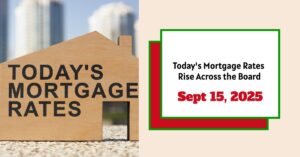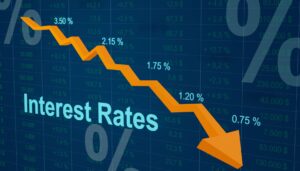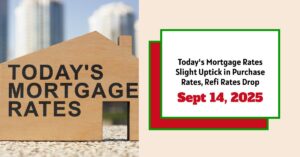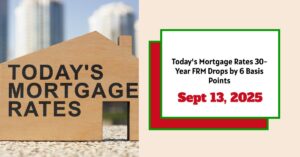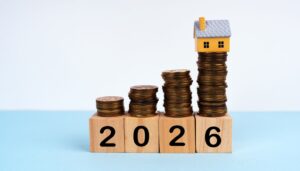On September 15, 2025, mortgage rates in the U.S. have shown mixed movement but a general upward trend, with the national average 30-year fixed mortgage rate increasing to 6.56%, up 11 basis points from last week’s 6.45%, according to Zillow. Refinancing rates followed a similar pattern: the 30-year fixed refinance rate increased to 6.75%, while the 15-year fixed refinance rate decreased to 5.50%. These shifts reflect a complex economic backdrop, including cooling labor market figures, Federal Reserve monetary policy expectations, and inflation trends.
Today's Mortgage Rates – September 15, 2025: Rates Jump Across the Board
Key Takeaways:
- 30-year fixed mortgage rates rose to 6.56% on September 15, 2025, up 11 basis points from last week.
- 15-year fixed mortgage rate decreased slightly to 5.57%; 5-year ARM also declined to 7.15%.
- 30-year fixed refinance rates increased to 6.75%, stable but up 10 basis points from one week ago.
- Labor market weakening and expected Federal Reserve rate cuts are key factors influencing these rates.
- Despite recent increases, mortgage rates remain high compared to historic lows seen in the early 2020s.
- Experts forecast modest declines later in 2025 and into 2026 but rates are expected to stay above 6% for now.
Current Mortgage Rates Overview – September 15, 2025
Mortgage rates influence homebuyers and homeowners who want to refinance their loans. Here is a snapshot of key mortgage rates nationally:
| Type of Loan | Current Rate (9/15/25) | Change From Last Week | Annual Percentage Rate (APR) | APR Change |
|---|---|---|---|---|
| 30-Year Fixed | 6.56% | +0.11% (11 basis points) | 7.13% | +0.23% |
| 15-Year Fixed | 5.57% | -0.02% | 5.92% | +0.12% |
| 5-Year ARM | 7.15% | -0.16% | 7.85% | +0.16% |
| 10-Year Fixed | 5.79% | 0.00% | 6.09% | 0.00% |
| 30-Year Fixed FHA | 7.25% | +1.59% | 8.28% | +1.62% |
| 30-Year Fixed VA | 5.99% | +0.09% | 6.16% | +0.06% |
(Source: Zillow, September 15, 2025)
Refinance Rates Today
Refinancing remains an essential opportunity for many homeowners hoping to reduce monthly payments or change loan terms. Let's see the current refinance rates:
| Type of Refinance Loan | Current Rate (9/15/25) | Change From Last Week | Annual Percentage Rate (APR) | APR Change |
|---|---|---|---|---|
| 30-Year Fixed Refinance | 6.75% | +0.10% | Not Specified | – |
| 15-Year Fixed Refinance | 5.50% | -0.04% | Not Specified | – |
| 5-Year ARM Refinance | 7.71% | 0.00% | Not Specified | – |
Why Are Mortgage Rates Changing? The Economic Backdrop
The movement in mortgage and refinancing rates is deeply tied to various economic signals, most notably labor market performance and Federal Reserve monetary policy expectations.
Labor Market Signals
The latest unemployment report for August 2025 showed:
- An increase in the unemployment rate from 4.2% in July to 4.3% in August.
- Only 22,000 jobs added in August, marking a slowdown.
This labor market cooling can sometimes lead to lower mortgage rates as it signals a slowing economy, which might prompt the Federal Reserve to ease monetary policy. However, the current rates’ mixed movement shows that other forces are at work as well.
Federal Reserve’s Influence
The Federal Reserve’s actions and their anticipation strongly move mortgage rates because mortgage-backed securities adjust to the Federal Reserve's interest rate policy.
- From 2021 through mid-2023, the Fed raised rates aggressively to fight inflation, pushing mortgage rates to two-decade highs.
- At the end of 2024, the Fed began cutting rates, but held steady through five meetings in 2025.
- Expectations are high for at least one 25 basis-point cut in the September 16-17, 2025 meeting, with markets pricing in a 91% chance.
- Economic data like slowing job growth encourages market optimism for rate cuts, which can lower mortgage rates.
Nevertheless, forecasts suggest mortgage rates are likely to remain above 6% for the near term, due to inflation persistence and various economic uncertainties.
Mortgage Rates Trends and Forecasts
Mortgage rates have hovered between 6.6% and 6.8% for much of 2025. Recent economic indicators, including weaker job reports and slight easing inflation, have slightly softened expectations about how high rates will go.
Economic experts and organizations provide these outlooks:
- National Association of REALTORS®: Anticipates average mortgage rates will hover around 6.4% in the second half of 2025 and ease to about 6.1% in 2026.
- Fannie Mae (August 2025 forecast): Predicts 30-year mortgage rates to end 2025 at 6.5% and drop to 6.1% in 2026. Mortgage originations are expected to rise as rates ease.
- Mortgage Bankers Association: Projects rates at about 6.7% at the end of 2025, falling to about 6.5% by end of 2026, with periods of refinancing volume increases and limited refinancing windows due to volatility.
- Realtor.com: Expects mortgage rates to slowly ease to about 6.4% by the end of the year, similar to the prior year.
Mortgage rates do not operate in isolation—they reflect the interplay between inflation, Federal Reserve actions, global market conditions, and government debt issuance.
How Do These Rates Affect Buyers and Refinancers?
With 30-year fixed mortgage rates climbing above 6.5%, home affordability remains a challenge for many prospective buyers. Monthly payments increase significantly even with small percentage changes in interest rates.
Example Calculation:
Imagine a borrower looking for a $400,000 mortgage:
- At 6.45% interest (last week’s average), the monthly principal and interest payment over 30 years would be roughly $2,505.
- At today's average 6.56%, the payment rises to about $2,538.
- That’s a $33 monthly increase or almost $400 more annually just due to this week's rate change.
Refinancing can potentially save borrowers money if they can reduce their interest rate by a meaningful margin. For homeowners with mortgages above 7%, the current refinance window represents a chance to lock in lower payments, especially if they foresee further rate declines.
Mortgage Rate Types and Variations
Mortgage loans come in different forms, each with unique rate structures:
- Fixed-rate mortgages: Maintain the same interest rate over the entire term. Common terms are 30-year and 15-year fixed.
- Adjustable-rate mortgages (ARMs): Start with a fixed rate for a period, then adjust periodically. The 5-year ARM, for example, often starts with a lower rate but can rise or fall depending on market conditions.
Current ARM rates remain somewhat higher, especially the 5-year ARM refinance rate at 7.71%, reflecting market uncertainties and expectations of future Federal Reserve moves.
Mortgage Types: Conforming vs. Government Loans
Mortgage rates differ depending on the loan type and backing entity.
- Conforming loans follow limits set by Fannie Mae and Freddie Mac. These loans have slightly lower rates than government loans.
- Government-backed loans like FHA and VA mortgages have their own rate dynamics, usually reflecting borrower risk.
As of September 15, 2025:
- FHA 30-year fixed rates climbed notably to 7.25%, reflecting higher risk premiums.
- VA 30-year fixed loans remain comparatively lower at 5.99%, reflecting VA guarantees.
The Federal Reserve’s Role: What Comes Next?
The Federal Reserve’s imminent September 2025 meeting is highly anticipated:
- A quarter-point rate cut is expected.
- Markets are pricing in potential for two additional cuts later in 2025.
- The Fed’s “dot plot” (projections for interest rates) will offer signals on rate trajectories.
These moves aim to balance continuing inflation control alongside supporting slower economic growth and a weakening labor market. With inflation still persistent but cooling, the Fed must tread carefully to prevent triggering recessions while lowering borrowing costs.
In-Depth Analysis: What Drives Mortgage Rate Volatility?
Mortgage rate volatility comes from several sources:
- Real-time economic data: Employment, inflation, and GDP reports.
- Treasury yields: Mortgage rates closely track the 10-year Treasury yield, which recently dipped to near its lowest since October 2024 at about 4.07%.
- Global economic conditions: Events abroad and world financial markets affect U.S. Treasury demand and rates.
- Federal Reserve messaging: Speeches, meeting minutes, and policy changes.
The intricate dance of these variables means mortgage borrowers face uncertainty and need to monitor the environment closely.
Related Topics:
Mortgage Rates Trends as of September 14, 2025
Mortgage Rates Predictions Next 90 Days: August to October 2025
Homebuyers and the Rate Environment
Housing affordability remains a top concern for many prospective buyers. Even small rate increases can shift monthly payments dramatically.
Persistent rates above 6% create a challenging backdrop, but with signs of potential Fed easing, buyers may find opportunities opening in the next few months.
Refinancers, especially, should watch for rate movements as opportunities to reduce long-term costs arise.
Mortgage Rate Summary Table – September 15, 2025
| Loan Type | Rate (%) | Movement from Last Week | Notes |
|---|---|---|---|
| 30-Year Fixed | 6.56 | +0.11 | Rising trend |
| 15-Year Fixed | 5.57 | -0.02 | Slight drop |
| 5-Year ARM | 7.15 | -0.16 | Declining slightly |
| 30-Year Fixed Refinance | 6.75 | +0.10 | Stable, slightly up |
| 15-Year Refine | 5.50 | -0.04 | Slight decline |
| FHA 30-Year Fixed | 7.25 | +1.59 | Sharp rise |
| VA 30-Year Fixed | 5.99 | +0.09 | Slight rise |
Capitalize Amid Rising Mortgage Rates
With mortgage rates expected to remain high in 2025, it’s more important than ever to focus on strategic real estate investments that offer stability and passive income.
Norada delivers turnkey rental properties in resilient markets—helping you build steady cash flow and protect your wealth from borrowing cost volatility.
HOT NEW LISTINGS JUST ADDED!
Speak with a seasoned Norada investment counselor today (No Obligation):
(800) 611‑3060
Also Read:
- Will Mortgage Rates Go Down in 2025: Morgan Stanley's Forecast
- Mortgage Rate Predictions 2025 from 4 Leading Housing Experts
- Mortgage Rate Predictions for the Next 3 Years: 2026, 2027, 2028
- 30-Year Fixed Mortgage Rate Forecast for the Next 5 Years
- 15-Year Fixed Mortgage Rate Predictions for Next 5 Years: 2025-2029
- Will Mortgage Rates Ever Be 3% Again in the Future?
- Mortgage Rates Predictions for Next 2 Years
- Mortgage Rate Predictions for Next 5 Years
- Mortgage Rate Predictions: Why 2% and 3% Rates are Out of Reach
- How Lower Mortgage Rates Can Save You Thousands?
- How to Get a Low Mortgage Interest Rate?
- Will Mortgage Rates Ever Be 4% Again?
